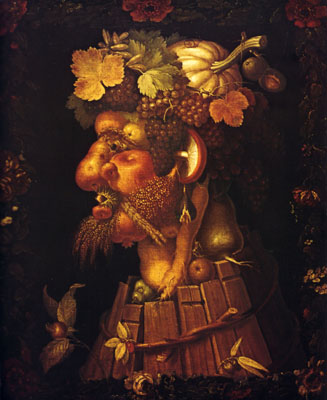With summer drawing to a close, this week’s picture is a personification of Autumn by the sixteenth-century northern Italian artist, Giuseppe Arcimboldo. A grizzled, florid male head, seen in late middle age – the autumn of life – has been cunningly composed from the fruits, nuts, tubers and other edible produce of the season. A weird fertility god, glowing with the colours of ripe and fruitful nature, he stares impassively into space, leaving the viewer to admire the intricate metamorphoses and artful, punning arrangements from which he has been formed.
Like Bacchus, the Roman deity closely identified with autumn, he is crowned with a wreath of vine leaves – and like Bacchus he seems of a bibulous disposition, to judge by the cascading bunches of grapes that shape his hair; the barley, hops and rye that beard him; and the wooden tun of his torso. He has a bulbous and warty nose – the nose itself being a knobbly pear, the wart a crab-apple – and a russet-red cheek. But not all of his attributes are those of the drinker. His tuberiferous neck is made of a potato, carrot and turnip. His beady eye is a dark shiny berry, his eyebrow an ear of corn, while his moustachioed mouth is formed by a sweet chestnut still half-housed within its spiky husk. His cranium is a pumpkin (a novelty in late sixteenth-century Europe, the first specimens of the gourd family having only recently been imported from the New World), around the stalk of which a pair of plums are decoratively twined. Something of a dandy, he wears a medlar as if it were a rosette, while a split-fig earring dangles dashingly from his wild mushroom ear.
Arcimboldo was prized by his contemporaries for his ability “to seek out the hidden resemblances...

ITP 74: Autumn by Giuseppe Arcimboldo
16-09-2001

